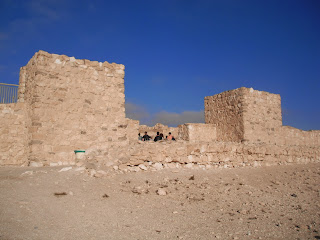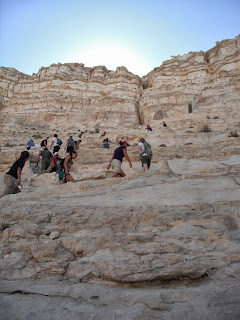Today we spend the day around (and
ultimately in) the Sea of Galilee. I feel that there is a lot that can be
discussed with the stories and things that happen around in this area and in a
way, some way that most of them tie together. Yesterday I talked the water and
creation imagery and also about the question of what do we do with the Romans. Today
we continued our conversation about what do we do with the Romans, but I feel
as if the themes that stood out to me were justice and discipleship.
We started out on a hill near
Bethsaida where it is suggested that Jesus taught the Sermon on the Mount. Here the world, the major road passes right
by. The Romans are stationed here. And Capernaum, the city just a stone’s throw
away, is the city where Jesus retreats to after speaking in Nazareth. In Nazareth
his reallocated the promise that the Jews thought was just for them for everybody,
including the Romans who they considered their enemy.
“Blessed
are the poor in spirit, for theirs is the kingdom of heaven.
Blessed
are those who mourn, for they will be comforted.
Blessed
are the meek, for they will inherit the earth.
Blessed
are those who hunger and thirst for righteousness, for they will be filled.
Blessed
are the merciful, for they will be shown mercy.
Blessed
are the pure in heart, for they will see God.
Blessed
are the peacemakers, for they will be called children of God.
Blessed
are those who are persecuted because of righteousness, for theirs is the
kingdom of heaven.
“Blessed
are you when people insult you, persecute you and falsely say all kinds of evil
against you because of me. Rejoice and be glad, because great is your reward in
heaven, for in the same way they persecuted the prophets who were before you.
The people that Jesus calls blessed do not seem to fit into the
groups that already exist in Jewish world. The Sadducees, Pharisees Essenes or
Zealots don’t hold all these attributes, rather these seem to stand out of all
of them. A Biblical definition of
Justice can be taken from Zechariah 7:10. It commands the people of God to look
out for the widow, the orphan, the poor and the stranger in the camp. These
commands are spoken throughout the Bible.
In the Sermon
on the Mount it seems that the people that Jesus is calling blessed are not the
powerful, the free, the ruling, the wealthy or any of the groups that the Jews
have already set in place. He turns their expectations of blessed on its
head.
Peace-makers, it isn’t just
compromising and letting things slide for the sake of peace. It isn’t the
passive avoidance of conflict but rather the aggressive pursuit of true peace,
turning the other cheek and in do so turning the shame to those who fight. Those
who mourn cover all of the people that are found in this place. The Jew, the
Roman, the poor, and the rich are all included.
Those who hunger and thirst for righteousness: each of the groups claims
to be chasing after righteous in the best way.
So Jesus presents this to everybody.
Promises that now include the whole world and calling blessed those who relate
to the world in such a way. Justice
working out in practical ways to care for those who can’t care for themselves,
the Romans, and the despised included. We also looked at Isaiah 58 and
Ephesians 2:14-22.
In connection with the creation
imagery that we talked about yesterday, I found it interesting how God stands
existentially apart above creation and in a similar way God is calling us to be
existentially apart from humanity, to be in the world but not of the world.
 |
| found a boat anchor, rocks with holes bored through them which could be strung together and used to as an anchor. |
Just
like the land of Israel was filled with many different opinions and perspectives
both friendly and hostile towards each other, the guys that Jesus called to be
his disciples seems to be a mix of those groups. There are some zealots, and some religious Jews,
there is a local tax collector and fishermen from nearby who didn’t like (or
went to some length to skirt around) the local tax collector, there were some
brothers who have a Greek and Jewish name....., and a couple more that we are
not sure where their background is. Whatever the case, Jesus chose some
interesting characters to have as his close disciples.
 |
| olive press |
 |
| building methods |
 |
| inside a reconstructed house |
I had heard before the Jesus was
likely a stone mason or builder because the word for carpenter is ‘tacton’ and that
is better translated to stone mason and fits better with the lack of abundance
of trees in the area. I find it interesting the idea that Rabbis still had a
day job, they were not only Rabbis. Jesus being the son of a tacton would also
learn that trade and ultimately end up working that while he was being a Rabbi.
It is interesting how a job like that would keep Jesus right in the middle of
the day to day lives of the people to whom he is speaking. If Jesus was living
and working in the area, did he already know his disciples as kids growing up?
Did he have his finger on the pulse of the people in the area?
 |
| inside of a roof/second floor of a house |
This past year I heard a pastor
speaking at a young adult worship service who worked part-time as a pastor of a
local church and part-time in the trades. He actually went through an apprenticeship
and was at the point of taking on apprentices himself and was using that as an
example of discipleship. It was interesting how he pointed out that being
part-time in the trades kept him touch with what was going on in the community
and gave opportunity for evangelism in a very practical way.
It is interesting to think about the
way that we look at and view ministry. My dad has reminded us again and again
that ministry can happen anywhere and maybe that is what Jesus was getting at
too. The God places us in certain places. God placed Israel in a land that has
the world passing by and through it so that the world could know who God is.





















































